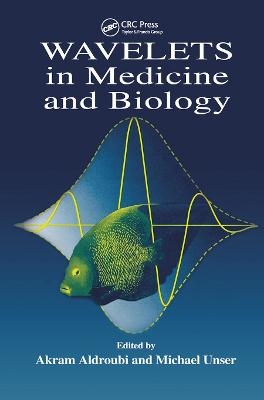
Wavelets in Medicine and Biology
Routledge (Verlag)
9780367448592 (ISBN)
Aldroubi, Akram | Unser, Michael
Part I Wavelet Transform: Theory and Implementation -- 1 The Wavelet Transform: A Surfing Guide /Akram Aldroubi -- 1.1 Introduction -- 1.2 Notations -- 1.3 The Continuous Wavelet Transform -- 1.3.1 The Continuous Wavelet Transform of 1-D Signals -- 1.3.2 Multidimensional Wavelet Transform -- 1.4 The Discrete Wavelet Transforms -- 1.4.1 The Dyadic Wavelet Transform -- 1.4.2 The Redundant Discrete Wavelet Transforms . -- 1.5 Multi resolutions and Wavelets -- 1.5.1 Multiresolution Approximations of L2 -- 1.5.2 Orthogonal MRA-Type Wavelets -- 1.5.3 Semi-Orthogonal MRA-Type Wavelet Bases -- 1.5.4 Bi-Orthogonal MRA-Type Wavelet Bases -- 1.5.5 Local and Global Characterization of Functions in Terms of Their Wavelet Coefficients -- 1.6 Special Bases of Scaling Functions -- 1.6.1 Interpolating Scaling Functions -- 1.6.2 Interpolating Wavelets -- 1.7 Applications and generalizations -- 1.7.1 Applications of the Wavelet Transform -- 1.7.2 Generalizations of the Wavelet Transform -- 1.8 Frame Representations -- 2 A Practical Guide to the Implementation of the Wavelet Transform /Michael Unser -- 2.1 Introduction -- 2.2 Basic Tools -- 2.2.1 Scaling Functions and Multiresolution Representations -- 2.2.2 Inner Products Via Discrete Convolutions -- 2.2.3 Boundary Conditions -- 2.3 Wavelet Bases (Nonredundant Transform) -- 2.3.1 Fast Dyadic Wavelet Transform -- 2.3.2 Implementation Details -- 2.3.3 Extensions -- 2.4 Dyadic Wavelet Frames -- 2.5 Nondyadic Wavelet Analyses -- 2.5.1 Wavelet Representation -- 2.5.2 Fast Redundant Dyadic Wavelet Transform -- 2.5.3 Fast Redundant Wavelet Transform with Integer Scales -- 2.5.4 Fast Redundant Wavelet Transform (Arbitrary Scales) -- 2.5.5 Fast Redundant Morlet or Gabor Wavelet Transform -- 2.6 Conclusion -- Part II Wavelets in Medical Imaging and Tomography -- 3 An Application of Wavelet Shrinkage to Tomography /Eric D. Kolaczyk -- 3.1 Introduction -- 3.1.1 Tomography -- 3.1.2 Why Wavelets? -- 3.1.3 Wavelet Shrinkage and the Proposed Method -- 3.2 Inversion -- 3.2.1 Direct Data Vs. Indirect Data -- 3.2.2 The Wavelet-Vaguelette Decomposition -- 3.2.3 Efficient Expressions for the Radon Vaguelette Coefficients -- 3.2.4 Calculation of the Radon Vaguelette Coefficient. -- 3.3 Denoising Using Wavelet Shrinkage -- 3.3.1 Wavelet Shrinkage with Direct Data -- 3.3.2 Wavelet Shrinkage with Tomographic Data -- 3.3.3 The Proposed Reconstruction Method -- 3.4 A Short Comparative Study -- 3.5 Discussion -- 4 Wavelet Denoising of Functional MRI Data /Michael Hilton, Todd Ogden, David Hattery, Guinevere Eden, and Bjorn Jawerth -- 4.1 Functional MRI and Brain Mapping -- 4.2 Image Acquisition -- 4.3 fMRI Time Series Analysis -- 4.3.1 The Hemodynamic Response Function -- 4.4 Wavelet Denoising of Signals -- 4.4.1 Data Analytic Thresholding -- 4.5 Experimental Results -- 4.5.1 Data Set Descriptions -- 4.5.2 Analysis Technique -- 4.5.3 Denoising Results -- 4.6 Conclusions -- 4.7 Acknowledgment -- 5 Statistical Analysis of Image Differences by Wavelet Decomposition /Urs E. Ruttimann, Michael Unser, Philippe Thevenaz, Chulhee Lee, Daniel Rio, and Daniel W. Hommer -- 5.1 Introduction -- 5.2 Wavelet Transform -- 5.3 Correlation of Wavelet Coefficients -- 5.4 Statistical Tests -- 5.5 Experimental Results -- 5.5.1 Functional Magnetic Resonance Images -- 5.5.2 Positron Emission Tomography Images -- 5.6 Discussion -- 6 Feature Extraction in Digital Mammography -- R. A. DeVore, B. Lucier, and Z. Yang -- 6.1 Introduction -- 6.2 Mammograms as Digitized Images -- 6.2.1 Characteristics of Mammographic Images -- 6.3 Compression and Noise Removal -- 6.4 Some Issues in Compression Algorithms -- 6.4.1 Choice of Wavelet Basis -- 6.4.2 Choice of Metric -- 6.4.3 Level of Compression -- 6.5 Algorithms -- 6.6 Examples -- 7 Multiscale Contrast Enhancement and Denoising in Digital Radiographs /Jian Fan and Andrew Laine -- 7.1 Introduction -- 7.2 One-Dimensional Wavelet Transform -- 7.2.1 General Structure and Channel Characteristics -- 7.2.2 Two Possible Filters -- 7.3 Linear Enhancement and Unsharp Masking -- 7.3.1 Review of Unsharp Masking -- 7.3.2 Inclusion of Unsharp Masking within RDWT Frame-Work -- 7.4 Nonlinear Enhancement -- 7.4.1 Minimum Constraint for an Enhancement Function -- 7.4.2 Filter Selection -- 7.4.3 A Nonlinear Enhancement Function -- 7.5 Combined Denoising and Enhancement -- 7.5.1 Incorporating Wavelet Shrinkage into Enhancement -- 7.5.2 Threshold Estimation for Denoising -- 7.6 Two-Dimensional Extension -- 7.7 Experimental Results and Comparisons -- 7.8 Conclusion -- 7.9 Acknowledgment -- 8 Using Wavelets to Suppress Noise in Biomedical Images /Maurits Malfait -- 8.1 Introduction -- 8.2 Overview of Wavelet-Based Noise Suppression -- 8.2.1 Wavelet Shrinkage -- 8.2.2 Correlating Coefficients Between Wavelet Levels -- 8.2.3 Smoothness Measure from Wavelet Extrema -- 8.2.4 Example -- 8.3 Introducing an A Priori Model -- 8.3.1 Motivation -- 8.3.2 Basic Idea and Notation -- 8.3.3 Bayesian Method -- 8.3.4 The Conditional Probability -- 8.3.5 The A Priori Probability -- 8.3.6 Coefficient Manipulation -- 8.4 Results for Biomedical Images -- 9 Wavelet Transform and Tomography: Continuous and Discrete Approaches /F. Peyrin and M. Zaim -- 9.1 Introduction -- 9.2 Basis of Tomography -- 9.2.1 Problem Position -- 9.2.2 Reconstruction Methods: Transform Methods . -- 9.2.3 Series Expansion Methods -- 9.3 Continuous Wavelet Decomposition -- 9.3.1 Continuous Wavelet Decomposition of Projections -- 9.3.2 Continuous Wavelet Decomposition of the Image -- 9.4 Discrete Wavelet Decomposition -- 9.4.1 1-D DWT of the Projections -- 9.4.2 2-D Discrete WT of the Image -- 9.5 Conclusion -- 9.5.1 Acknowledgments -- 9.6 Appendix 1 -- 10 Wavelets and Local Tomography /Carlos A. Berenstein and David F. Walnut -- 10.1 Introduction -- 10.2 Background and Notation -- 10.3 Why Wavelets? -- 10.3.1 The Nonlocality of the Radon Transform -- 10.3.2 Wavelets, Vanishing Moments, and A-Tomography -- 10.4 Wavelet Inversion of the Radon Transform -- 10.4.1 The Continuous Wavelet Transform -- 10.4.2 The Semi-Continuous Wavelet Transform -- 10.4.3 The Discrete Wavelet Transform -- 10.5 Wavelet Localization of Radon Transform -- 10.6 Conclusions -- 10.7 Appendix: Proofs of Theorems -- 10.8 Acknowledgments -- 11 Optimal Time-Frequency Projections for Localized Tomography /Tim Olson -- 11.1 Introduction -- 11.1.1 Historical Notes -- 11.1.2 Prior Work -- 11.1.3 Organization -- 11.2 Algorithmic Goals -- 11.3 Background -- 11.3.1 The Radon Transform -- 11.3.2 Basic Fourier Analysis -- 11.4 Reconstruction Techniques -- 11.4.1 Fourier Reconstruction -- 11.4.2 Filtered Back projection -- 11.4.3 Nonlocality of the Radon Inversion -- 11.4.4 Visualization via the Sinogram -- 11.4.5 Comparison to Local Tomography -- 11.5 Localization -- 11.5.1 Utilizing Functions with Zero Moments -- 11.5.2 How Many Frequency Windows? -- 11.5.3 High Frequency Computation -- 11.5.4 Low Frequency Computation -- 11.5.5 The Algorithm -- 11.6 Numerical Results -- 11.7 Optimality -- 11.7.1 Minimization of Nonlocal Data -- 11.8 Conclusion -- 11.9 Appendix: Error Analysis -- 11.9.1 Aliasing Error Analysis -- 11.9.2 Truncation Error Analysis -- 11.10 Local Cosine and Sine Bases -- 11.11 Acknowledgments -- 12 Adapted Wavelet Techniques for Encoding Magnetic Resonance Images /Dennis M. Healy, Jr. and John B. Weaver -- 12.1 Introduction -- 12.2 Encoding in Magnetic Resonance Imaging -- 12.2.1 Nuclear Magnetic Resonance -- 12.2.2 Imaging -- 12.2.3 Imaging Time and Signal-to-Noise Ratio -- 12.3 Adapted Waveform Encoding in MRI -- 12.3.1 MRI Encoding with a Basis -- 12.3.2 Figures of Merit in Adapted Waveform Encoding -- 12.3.3 Choosing a Basis for Encoding -- 12.3.4 Implementation of Adapted Waveform Encoding -- 12.4 Reduced Imaging Times -- 12.4.1 Adapted Waveform Encoding with K-L Bases . -- 12.4.2 Approximate K-L Bases -- 12.4.3 Approximate Karhunen-Loeve Encoding -- 12.5 Conclusions -- 12.6 Acknowledgments -- Part III Wavelets and Biomedical Signal Processing -- 13 Sleep Images Using the Wavelet Transform to Process Polysomnographic Signals /Richard Sartene, Laurent Poupard, Jean-Louis Bernard, and Jean-Christophe Wallet --
| Erscheinungsdatum | 16.01.2021 |
|---|---|
| Verlagsort | London |
| Sprache | englisch |
| Maße | 156 x 234 mm |
| Gewicht | 893 g |
| Themenwelt | Mathematik / Informatik ► Mathematik ► Analysis |
| Mathematik / Informatik ► Mathematik ► Angewandte Mathematik | |
| Medizin / Pharmazie ► Physiotherapie / Ergotherapie ► Orthopädie | |
| Technik ► Medizintechnik | |
| ISBN-13 | 9780367448592 / 9780367448592 |
| Zustand | Neuware |
| Informationen gemäß Produktsicherheitsverordnung (GPSR) | |
| Haben Sie eine Frage zum Produkt? |
aus dem Bereich


